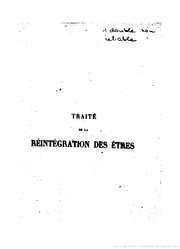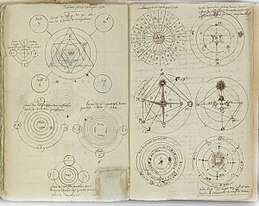Order of Knight-Masons Elect Priests of the Universe
| Ordre des Chevaliers Maçons Élus Coëns de l’Univers | |
 The Élus Coëns Seal of Pasqually | |
| Formation | 1767 |
|---|---|
| Type | Christian magical organisation |
| Location |
|
| Leader |
|
The Order of Knight-Masons Elect Priests of the Universe (French: Ordre des Chevaliers Maçons Élus Coëns de l’Univers) or simply Élus Coëns (sometimes misspelled ‘Elus Cohens’ or ‘Kohens’,[1] Hebrew for ‘Elect Priests’), was a theurgical organisation founded by Martinès de Pasqually. It appeared in France in the second half of the 18th century and is the first branch of Martinist tradition, otherwise known as Martinezism.
Doctrine


General teaching
The Élus Coëns is an Esoteric Christian order founded in 1767, with its focus on establishing an invisible church, independent of any earthly structure, to find the path that leads to the hidden knowledge of nature in anticipation of the coming destruction of the material Church. That is to say, by a progressive initiation and a direct knowledge of God to obtain the primordial unity, which was lost since the fall of Adam—the Reintegration—through the practice of theurgy, which relied on complex ceremonial practices aimed at what Pasqually termed the reconciliation of the ‘minor’ person with Divinity. This was to be accomplished through human communication with the angelic hierarchies.[2] In other words, they practised theurgy which consisted of evoking the intermediary spirits, such as angels and celestial beings in order to obtain their help and support. With this in mind, the Masonic system provides an adequate structure for this course taken using occultist methods.[3]
The teachings address essentially major themes relating to the Judeo-Christian tradition, but from an esoteric point of view, under the Cabbalistic and Valentinian-gnostic influences found in Pasqually’s own texts, rituals and catechisms.[1] They drew upon the power of Church prayers, banished the influence of Satan from humanity.[4]
The Architect
Hiram Abiff—the allegorical figure of Freemasonry—is also presented in the Martinezist tradition, but with a different view. According to an archive from Lyon Library, the Private Instructions to the Coëns of Lyon, Hiram was not murdered but simply retired from his job because the King Solomon fell into sins. He could not die because he was not an ordinary mortal but being a sublime essence, a bearer of holiness, an architect sent to Solomon by the Great Architect of the Universe. It is also described in the archive that he is one of the six great elects, among whom are Hely, Enoch, Melchizedek, Ur and Elijah. All of them precede the seventh and final elect – the Corrector or Mender, our Lord Jesus Christ. But it was Hiram, being the chief architect of the Temple of King Solomon, foreshadowed by his appearance the coming of the Son of God (Jesua Messiah), as the Great Architect of the New Testament Church.
This view of Martinezism developed in higher degrees is completely distinct from the Freemasonry’s, departed from Masonic symbolism and ordinary Masonic works, the Coëns introduced a mystical philosophy, a detailed description of which can be found in Pasqually’s Treatise on the Reintegration of Beings into Their Original Estate, Virtues and Powers both Spiritual and Divine (Traité de la Réintégration des êtres dans leurs premières propriétés, vertus et puissance spirituelles et divines).
Origin myth and history
The history of the Élus Coëns, like the history of any secret society, is quite complex and confusing. The history has been preserved in very few written documents that could shed light on the order that remains almost unknown for more than two centuries. However, its history can be divided into a legendary one and an actual one.
Legendary history
The legendary history, according to Pasqually’s Treatise on the Reintegration of Beings, the fundamental book of Élus Coëns, the teachings taught in the order derive from the teachings that Seth, the third son of Adam, received from the Angels, which including certain rituals and reconciliation of humanity with God. But the descendants of Seth perverted this knowledge, thus it became useless, until it was retransmitted by Noah. Since then, it has passed through the ages, through a continuous chain of the tradition of initiation to the Rosicrucians. The higher mystery of the Rosicrucian brotherhood was taught at the highest level of the Order of the Elect Priests, which had the designation ‘R+’ that means ‘Reaux-Croix’ (‘Pink Cross’ or ‘Ruddy Cross’).
It is believed that the doctrine transmitted in the Order of the Elect Priests, especially the teaching of ‘R+’ level, was the axis and the basic doctrine of all the preceding esoteric brotherhoods, societies and orders that existed before the emergence of the Elect Priests. Moreover, according to the Treatise, all the Old Testament prophets, for example, Moses, Elijah, Isaiah, Ezekiel, Daniel, King Solomon and his architect Hiram Abiff, among others; as well as many New Testament figures and mystics, among them the Twelve Apostles of Jesus Christ and theologians and teachers of the early Christian church; also various legendary figures, such as Christian Rosenkreuz, were all the Elect Priests of the universe.
Documented history
Aftermaths
In 1772, Martinès de Pasqually left France on family business for Haiti, two years later he died in Santo Domingo. Two of his disciples particularly distinguished themselves: Jean-Baptiste Willermoz and Louis Claude de Saint-Martin.
Jean-Baptiste Willermoz was an ardent adept of Freemasonry and theurgy. For him, the doctrine of Reintegration is at the base of primitive and authentic masonry that is to be found by the meeting on this basis of all ‘rites and systems’. He joined the German Order of Strict Templar Observance in 1773, the order was reformed by Willermoz under a new name, the Chevalier Bienfaisant de la Cité Sainte, which combined Templar Freemasonry with the ceremonial of the Élus Coëns.
Meanwhile, Louis Claude de Saint-Martin had renounced Freemasonry and the theurgy used by Élus Coëns. By judging these methods of angelic evocation to be unreliable and even dangerous, he chose to take another path, what he called ‘The Way of the Heart’ to attain the Reintegration, the inward contemplation that opposes the exterior theurgic ritual.
At the end of the 19th century, various occultist currents reclaimed Martinès de Pasqually—among them, the Ordre de la Rose-Croix catholique du Temple et du Graal—founded in 1890 by Joséphin Péladan, which claimed to fight against the ‘Latin Decadence’ by the return to the religion of the ‘Art God’ and an imperial theocracy.[3]
The order was revived by Robert Ambelain in 1942 (under the name Ordre Martiniste des Élus Cohens)[5] on the basis of a few rare documents, among them, the most well-known one is the Manuscrit d’Alger discovered by Ambelain himself, currently preserved in the Bibliothèque nationale de France.[6] He initiated two new members in the same year and became leader of the order since 1946.[5]
References
- 1 2 "Elus Coën". Ordre Reaux Croix. Retrieved 7 April 2018.
- ↑ Rebisse, Christian (2014). Rosicrucian Digest: Martinism (PDF). San Jose, California: AMORC. p. 3.
- 1 2 Martin, Jean-Clément (2011). Dictionnaire de la Contre-Révolution (in French). Paris: Perrin. pp. 262 and 263. ISBN 978-2-262-03370-5.
- ↑ Ambelain, Robert (1971). "Martinists". Man, Myth & Magic 62. London: Punrell. pp. 1746–47.
- 1 2 Roggemans, Marcel (2009). History of Martinism and the F.U.D.O.S.I. Translated by Bogaard, Milko. Morrisville, North Carolina: Lulu Press. pp. 128 and 134. ISBN 978-1-4092-8260-0.
- ↑ Preserved under the title Manuscrit des Élus Cohens (cote FM4 1282)
